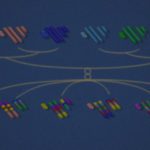Link to Pubmed [PMID] – 23151488
Genes Immun. 2013 Jan;14(1):35-41
We have previously described SEG/Pas as the first mouse inbred strain able to survive subcutaneous injection of virulent Yersinia pestis, the agent of plague, and we identified Yprl1, Yprl2 and Yprl3 as three quantitative trait loci (QTLs) controlling this exceptional phenotype in females from a backcross between SEG/Pas and C57BL/6 strains. We have now developed congenic strains to further characterize the extent and effect of these genomic regions. In this study, we confirm the importance of two of these regions, both in males and females, while the third one may well be a spurious association. We show that no genomic region alone is able to increase the survival of C57BL/6 mice, but that C57BL/6 mice carrying both Yprl2 and Yprl3 exhibit intermediate resistance. Each of these two QTLs contains at least two subregions, which are required to increase survival. Finally, through the analysis of congenic strains in an F1 background, we establish the mode of inheritance of the SEG-derived resistance alleles. Altogether, this study has clarified and enhanced our understanding of the genetic architecture of resistance to plague in SEG/Pas mice.




